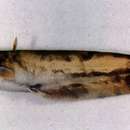Diagnostic Description
provided by Fishbase
The side of the dorsal is dark grey; white stomach; with irregular white dots on the side. One pair of maxillary barbel, longer than the head; one pair of mandibular barbels, about 1/5-1/3 the length of the maxillary barbel (Ref. 40516).
Life Cycle
provided by Fishbase
Pairs manifest spawning embrace widely observed in other catfish species (Ref. 37360).Details of reproductive behaviour from Katano, et al (1988): " A male first energeticaly pursued a female with its head near to the female's belly (chasing) and then began to cling to the female's body from the side, bending its tail or head (clinging). Finally the male enfolded the female's body, with its anus near to the female's (enfolding). In some cases, 2-4 males pursued a single female and two males enfolded a female at the same time. Although no aggressive behaviour was evident between males, it was always the largest male that could almost frequently approach and enfold the female. The mating pair moved a long distance in a ditch, paddy field and/or creek, performing reproductive activities."The scattering of eggs may reduce the incidence of death of the young.
Morphology
provided by Fishbase
Dorsal soft rays (total): 4; Analsoft rays: 67 - 84
Trophic Strategy
provided by Fishbase
Mostly found in rivers, lakes, and reserviors. Hide in swamps and caves during the day time and feeding during the night. Stays in deep waters and muddy places during winter (Ref. 40516). Feeds on all types of fish (Ref. 41072). Recorded as having been or being farmed in rice fields (Ref. 119549).
Biology
provided by Fishbase
Commercially cultured in Japan. Adults feed on all types of fish (Ref. 41072). Recorded as having been or being farmed in rice fields (Ref. 119549).
Importance
provided by Fishbase
fisheries: commercial; aquaculture: commercial

